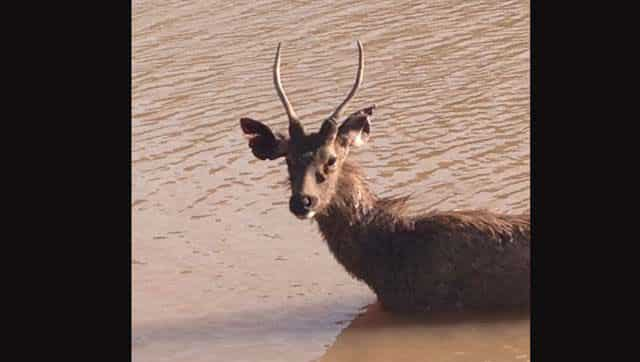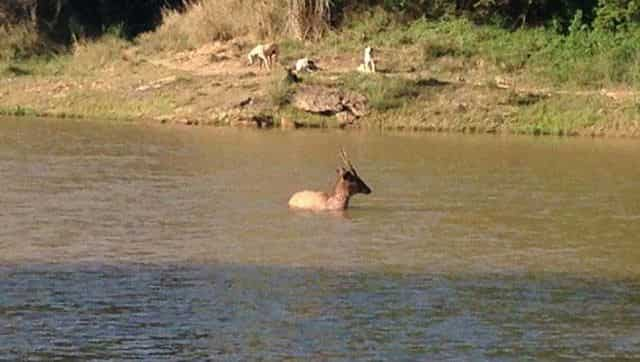wild buzz: Waterboarding, Doggie Ishtyle
If you happen to visit the water holes and check dams in the tricity's peripheral jungles, you will come across skeletons of sambars/neelgai strewn on the banks. Mostly of fawns, like young buds, plucked prematurely, snuffed out and trampled upon in the swirling dust. Village dogs orchestrate these macabre deaths, on some occasions over 48 hours.Writes Vikram Jit Singh
Waterboarding, Doggie Ishtyle

On March 27 in the early evening, I stumbled upon seven dogs that had corralled a young stag in a dam at Choti-Badi Nagal village. Aged herdsman Dhani Ram, who was grazing his cows, told me "the dogs had been at it since morning and that the stag's fate was preordained."

Photo Caption:The helpless, tired look in stag's eyes.Vikram Jit Singh/HT Photo
"The stag comes out of water, runs up the nallah but is again chased back into water by dogs. This will continue for hours till the stag’s body goes cold, dripping and cumbersome with prolonged exposure to water, and its heart is affected. The stag will again make a dash for it but this time it will fall down in exhaustion and terror, and the dogs will bite it to death," explained Ram. If you can imagine being chained with 50 kgs of weights and then trying to outrun half-a-dozen honey bee swarms which eventually sting you to a squirming death, you will have come to a precise imagination of how closure finally comes for sambars: via a thousand vicious bites and snarls, a millennium of moments of helplessness and terror, and the agony of having flesh ripped even as truant death teases with a few more minutes of unwanted life.
Photo Caption: Dogs cut off the stag's escape routes. Vikram Jit Singh.HT/Photo
Determined to save the stag, I circled the dam armed with my stout walking stick chasing away the hounds. The script played out exactly as Ram had predicted, with the sambar's dash from water ending in a crashing return a few minutes later. The problem was that the sambar would run up a few nallahs only and the seven dogs had him covered. As evening fell, I, too, decided to submit to fate and give up the rescue mission. But it was as if the stag had sensed my defeat and it looked at me with those appealing liquid eyes, pierced through with trauma. I decided to give a last try, and it worked! The stag swam to the opposite side and vanished way up a nallah even as I held the dogs at bay. But as I trudged up the hillsides to reach my car before nightfall, I again heard blood-curdling barks. Had they again sniffed out the stage
In next week's column, I will tell you the final outcome of the hunt and whether my hopes were but a flattering emotion, a proverbial parasite preying upon human sensibilities as Shakespeare would have put it.
THE SIGN OF 3

Photo credit: Vikram Jit Singh/HT Photo
I would never have noticed this tree laden with pinkish blossoms had it not been for the wind and the shade of a sandy, wet nallah. On a ramble into the jungles near Jainti Majri village, I paused for rest in this nallah. A cool wind stirred the trees growing out from the nallah's walls and blossoms floated down. I looked up and saw eight trees growing in a row. Wind and water brought seeds down from distant, higher slopes, and here both these premier agencies of nature's proliferation had enticed me to eye their progeny. I broke a branch of the tree, characterised by (usually) trifoliate leaflets, and showed it to eminent botanist, Dr SP Khullar. Botanists, Dr Nidhan Singh and Dr DS Rawat, of the renowned efloraofindia group, also helped me identify and profile what turned out to be a "scarce tree of our region".
This tree, which blossoms between March and May and is found in India, Nepal, Pakistan and Bhutan, is known as Sadan with the alternative scientific names of Ougenia oojeinensis/Ougeinia dalbergioides/Desmodium oojeinense. It is a medium-sized tree (10-15m) that reaches 4,000 feet in elevation. Its wood is used for containers for churning curd, leaves for fodder and derivatives for medical use and fish poison. It often grows on steep slopes with roots exposed to air to develop new individuals (root suckers) which flower even in their younger stage. Its preferred habitat is inaccessible thickets.
Email of the writer: vjswild1@gmail.com



